
Slottsbacken
Encyclopedia
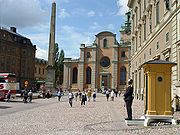
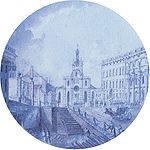
Street
A street is a paved public thoroughfare in a built environment. It is a public parcel of land adjoining buildings in an urban context, on which people may freely assemble, interact, and move about. A street can be as simple as a level patch of dirt, but is more often paved with a hard, durable...
in Gamla stan
Gamla stan
Gamla stan , until 1980 officially Staden mellan broarna , is the old town of Stockholm, Sweden. Gamla stan consists primarily of the island Stadsholmen. The surrounding islets Riddarholmen, Helgeandsholmen, and Strömsborg are officially part of, but not colloquially included in, Gamla stan...
, the old town in central Stockholm
Stockholm
Stockholm is the capital and the largest city of Sweden and constitutes the most populated urban area in Scandinavia. Stockholm is the most populous city in Sweden, with a population of 851,155 in the municipality , 1.37 million in the urban area , and around 2.1 million in the metropolitan area...
, Sweden
Sweden
Sweden , officially the Kingdom of Sweden , is a Nordic country on the Scandinavian Peninsula in Northern Europe. Sweden borders with Norway and Finland and is connected to Denmark by a bridge-tunnel across the Öresund....
.
It stretches east from the Stockholm Cathedral
Storkyrkan
Sankt Nikolai kyrka , most commonly known as Storkyrkan and Stockholms domkyrka , is the oldest church in Gamla Stan, the old town in central Stockholm, Sweden. It is an important example of Swedish Brick Gothic...
and the Royal Palace
Stockholm Palace
The Stockholm Palace is the official residence and major royal palace of the Swedish monarch. . Stockholm Palace is located on Stadsholmen , in Gamla Stan in the capital, Stockholm...
down to the street Skeppsbron
Skeppsbron
Skeppsbron is both a street and a quay in Gamla stan, the old town of Stockholm, capital of Sweden, stretching from the bridge Strömbron in front of the Royal Palace southward to Slussen....
which passes along the eastern waterfront of the old town. In the western end, the alley Källargränd
Källargränd
Källargränd is an alley in Gamla stan, the old town in central Stockholm, Sweden, connecting Slottsbacken, the slope south of the Royal Palace, to the square Stortorget...
leads south to the square Stortorget
Stortorget (Stockholm)
Stortorget is a small public square in Gamla Stan, the old town in central Stockholm, Sweden. It is the oldest square in Stockholm, the historical centre around which the medieval urban conglomeration gradually came into being...
, while Storkyrkobrinken
Storkyrkobrinken
Storkyrkobrinken is a street in Gamla stan, the old town in central Stockholm, Sweden.Leading from Högvaktsterrassen near the Royal Palace down to Myntgatan and Riddarhustorget it forms a parallel street to Salviigränd and Stora Gråmunkegränd and is crossed by Trångsund, Prästgatan, and...
extends Slottsbacken west beyond the cathedral and Högvaktsterrassen
Högvaktsterrassen
Högvaktsterrassen is a street in Gamla stan, the old town in central Stockholm, Sweden passing west of Yttre Borgården, the outer court of the Stockholm Palace....
, down to the square Riddarhustorget
Riddarhustorget
Riddarhustorget is, arguably, a public square in Gamla stan, the old town in central Stockholm, Sweden, named after its location in front of House of Knights ....
. On the southern side of Slottsbacken, three alleys connect to the interior throng of the old town: On either side of the Tessin Palace
Tessin Palace
The Tessin Palace is a baroque town house located in Gamla Stan, the old town in central Stockholm. Located next to the Royal Palace, it is facing Slottsbacken, the major approach to the Stockholm Palace, and flanked by two alleys, Finska Kyrkogränd and Bollhusgränd.The mansion was constructed...
are Finska Kyrkogränd
Finska Kyrkogränd
Finska Kyrkogränd is a blind alley in Gamla stan, the old town in central Stockholm, Sweden. Leading south from Slottsbacken, the alley separates the Finnish Church from the Tessin Palace, and was named after the vicinity to the former...
and Bollhusgränd
Bollhusgränd
Bollhusgränd is an alley in Gamla stan, the old town in central Stockholm, Sweden. Named after Bollhuset, a historical theatre, it connects Slottsbacken to Köpmantorget, and as Baggensgatan extends the alley further south beyond Köpmangatan, together they form a parallel street to Österlånggatan...
, while Österlånggatan
Österlånggatan
Österlånggatan is a street in Gamla stan, the old town of Stockholm, Sweden. Stretching southward from Slottsbacken to Järntorget, it forms a parallel street to Baggensgatan and Skeppsbron...
begins in the low-lying eastern part of the slope.
History
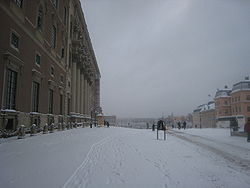
The present palace, designed by Nicodemus Tessin the Younger
Nicodemus Tessin the Younger
Count Nicodemus Tessin the Younger was a Swedish Baroque architect, city planner, and administrator.The son of Nicodemus Tessin the Elder and the father of Carl Gustaf Tessin, Tessin the Younger was the middle-most generation of the brief Tessin dynasty, which have had a lasting influence on...
and built in 1697-1760, was preceded by the Medieval castle Tre kronor
Tre kronor (castle)
Tre Kronor or Three Crowns was a castle located in Stockholm, Sweden, on the site where Stockholm Palace is today. It is believed to have been a citadel that Birger Jarl built into a royal castle in the middle of the 13th century...
("Three Crowns") which was continuously rebuilt during it existence and was finally destroyed by fire in 1697. South of this older building was in medieval times a slope consisting of sand and gravel, deliberately left unbuilt for defensive purposes. Probably wider than the present slope, it stretched further south to the royal stables, the kitchen gardens, and the butchers stalls on the opposite side. In 1520, the burghers of the city were requested to relocate their stables and piggeries from the "Stable Slope" (Stallbacken) to the hills surrounding the city. New defensive walls were built around the royal palace during the 16th century on the expense of the open area surrounding it, defensive constructions outdated in the early 17th century.
By the end of the 17th century, the slope had been transformed into an extremely narrow street squeezed between the wide moat of the palace and the variegated structures lined-up on the southern side. Parts of the five metres deep moat was used as a theatre and furnished with a superstructure.
As the new palace was being built, the slope was redesigned to become the palace's grand-style Baroque antechamber, and the structures and gardens on the southern side were consequently replaced by more prestigious buildings in stone. While the exterior of the Palace was more or less completed in the 1750s, the work on the slope, the palace's main approach, was still proceeding by the end of that century.
Royal Palace
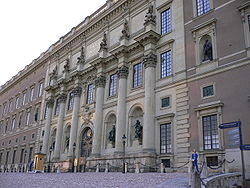


Though the four façades of the Royal Palace are all built in brick and bound by a unitary programme, they are all given distinctive designs in accordance to their various functions. The southern façade, representing the Nation and concealing the Royal Chapel and the Rikssal ("National Hall", the royal throne room), is facing the palace's main approach and is consequently the most pompous of the four. It is dominated by a Roman triumphal arch composition dressed in limestone
Limestone
Limestone is a sedimentary rock composed largely of the minerals calcite and aragonite, which are different crystal forms of calcium carbonate . Many limestones are composed from skeletal fragments of marine organisms such as coral or foraminifera....
and furnished with six war trophies, four abduction scenes by Bouchardon
Edmé Bouchardon
Edmé Bouchardon was a French sculptor, esteemed in his day as the greatest sculptor of his time and valued as a draughtsman as well.-Biography:...
, and 16 reliefs displaying mythological scenes. The balustrade over the central part was originally intended to be furnished with a series of sculptures. While the tall central portion, 115 metres wide, is flanked by a 48 metres long eastern wing, the corresponding western wing is limited to a mere 11 metres, as the original plans of the architect to demolish the Medieval cathedral were ignored. The statues in the eight niches, dating from 1899–1902, depict prominent Swedes from the late 17th century: Dahlbergh
Erik Dahlberg
Count Erik Jönsson Dahlbergh was a Swedish engineer, soldier, and field marshal, called the "Vauban of Sweden".- Life :...
, M. Stenbock
Magnus Stenbock
Count Magnus Gustafsson Stenbock was a Swedish military officer at the time of the Great Northern War.He was the son of Gustaf Otto Stenbock and Christina Catharine de la Gardie....
, Stiernhielm
Georg Stiernhielm
Georg Stiernhielm was a Swedish civil servant, linguist and poet. Stiernhielm was born in a middle-class family in the village Svartskär in Vika parish in Dalarna...
, Polhem
Christopher Polhem
Christopher Polhammar , better known as , which he took after his ennoblement, was a Swedish scientist, inventor and industrialist. He made significant contributions to the economic and industrial development of Sweden, particularly mining.-Biography:Polhem was born on the island of Gotland...
, Tessin
Nicodemus Tessin the Younger
Count Nicodemus Tessin the Younger was a Swedish Baroque architect, city planner, and administrator.The son of Nicodemus Tessin the Elder and the father of Carl Gustaf Tessin, Tessin the Younger was the middle-most generation of the brief Tessin dynasty, which have had a lasting influence on...
, Adelcrantz
Carl Fredrik Adelcrantz
Carl Fredrik Adelcrantz was a Swedish architect and civil servant. Adelcrantz's style developed from a rococo influenced by Carl Hårleman, the leading architect in Sweden in the early years of his career, to a classical idiom influenced by the stylistic developments in France in the mid-to-late...
, Linnaeus
Carolus Linnaeus
Carl Linnaeus , also known after his ennoblement as , was a Swedish botanist, physician, and zoologist, who laid the foundations for the modern scheme of binomial nomenclature. He is known as the father of modern taxonomy, and is also considered one of the fathers of modern ecology...
and von Dalin
Olof von Dalin
Olof von Dalin was a Swedish nobleman, poet, historian and courtier. He was an influential literary figure of the Swedish Enlightenment.-Background:...
.
Stockholm Cathedral
The five sections of the eastern façade of the Stockholm Cathedral reflects the three original, medieval nave and aisles and the flanking two aisles.The marble statue of Olaus Petri
Olaus Petri
Olof Persson , better known under the Latin form of his name, Olaus Petri , was a clergyman, writer, and a major contributor to the Protestant Reformation in Sweden...
(1493–1552), dating from 1897 and carved by Theodore Lundberg, celebrates the reformer who, inspired by studies in Germany paid by King Gustav Vasa
Gustav I of Sweden
Gustav I of Sweden, born Gustav Eriksson of the Vasa noble family and later known simply as Gustav Vasa , was King of Sweden from 1523 until his death....
, translated the Bibel to Swedish and had a crucial roll in the development of the Swedish language. He was the head of the church 1543-1552 and is buried in it.
In the cobbled pavement between the cathedral and the palace are two markings showing the location of the south-west bastion of the medieval palace and the eastern sanctuary of the medieval church destroyed by King Gustav Vasa
Gustav I of Sweden
Gustav I of Sweden, born Gustav Eriksson of the Vasa noble family and later known simply as Gustav Vasa , was King of Sweden from 1523 until his death....
to give the cannons of the palace more aiming space.
The Royal Household
Built in 1910 to the design of Erik Josephson (1864–1929), the tall building on number 2 was much criticized as it replaced a lower building, the concave façade of which made the space in front of the palace wider and more prominent, and the 'tenement Baroque' (hyreshusbarock) it represented was regarded as objectionable for the royal setting. The building is, however, occupied by the Royal Household (Hovstaterna).Tessin Palace
In respect to the vicinity to the royal palace and as a consequence of the irregularly shaped lot, the relatively discreet three-story façade of the private palace of Nicodemus Tessin the YoungerNicodemus Tessin the Younger
Count Nicodemus Tessin the Younger was a Swedish Baroque architect, city planner, and administrator.The son of Nicodemus Tessin the Elder and the father of Carl Gustaf Tessin, Tessin the Younger was the middle-most generation of the brief Tessin dynasty, which have had a lasting influence on...
, unveils very little of the elaborated Baroque garden in the interior court. The lime stone portal by Ferdinand Foucquet, one of the most prominent monumental sculptors of the Swedish Baroque era, gives an inviting hint of the richly decorated interior. The façade was originally flanked by two walls perpendicular to the façade.
The building is today the residence of the county governor
County governor
A county governor is the leader of a county, the first-level administrative unit of Lithuania. County governors are chosen by the Prime Minister and confirmed by the central government rather than elected by the people...
of Stockholm.
Finnish Church

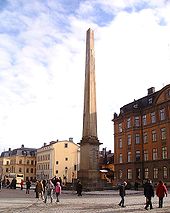

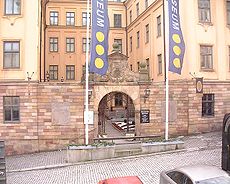
Finland
Finland , officially the Republic of Finland, is a Nordic country situated in the Fennoscandian region of Northern Europe. It is bordered by Sweden in the west, Norway in the north and Russia in the east, while Estonia lies to its south across the Gulf of Finland.Around 5.4 million people reside...
was a part of Sweden until 1809, and the national parish of the Finnish Church was established in Stockholm in 1533, at the time accommodated in the old abbey of the Blackfriars. A building constructed on the present site 1648-1653, originally intended for ball games, and thus called Lilla bollhuset ("Small Ball House"), but mostly used as a theatre, was taken over by the Finnish parish in 1725 from when the irregularly shaped building stems. In the interior, the organ loft still resembles the gallery of the old Boll House. As the church never had an accompanying graveyard, the Church of Catherine
Katarina kyrka
Katarina kyrka is one of the major churches in central Stockholm, Sweden. The original building was constructed 1656–1695. It has been rebuilt twice after being destroyed by fires, the second time during the 1990s...
on Södermalm
Södermalm
Södermalm, often shortened to "Söder", is a district in central Stockholm. It covers the large island formerly called "Åsön". With a population of 99,685, it is one of the most densely populated districts of Scandinavia...
was of great importance to the Finnish parish until the 19th century.
The obelisk
The 22 metres tall graniteGranite
Granite is a common and widely occurring type of intrusive, felsic, igneous rock. Granite usually has a medium- to coarse-grained texture. Occasionally some individual crystals are larger than the groundmass, in which case the texture is known as porphyritic. A granitic rock with a porphyritic...
obelisk
Obelisk
An obelisk is a tall, four-sided, narrow tapering monument which ends in a pyramid-like shape at the top, and is said to resemble a petrified ray of the sun-disk. A pair of obelisks usually stood in front of a pylon...
from 1800, is the design of architect Jean Louis Desprez. Commissioned by King Gustav III
Gustav III of Sweden
Gustav III was King of Sweden from 1771 until his death. He was the eldest son of King Adolph Frederick and Queen Louise Ulrica of Sweden, she a sister of Frederick the Great of Prussia....
and erected by the inventor and colonel-mecanicus Jonas Lidströmer
Jonas Lidströmer
Jonas Lidströmer was a Swedish inventor and officer in the Swedish navy.Lidströmer was born in 1755 at Lagfors bruk, Medelpad, and died 1808 in Stockholm...
, it was a product of the kings gratitude to the burghers of Stockholm who guarded the city while the king was at war with Russia in 1788-1790. Inspired by Egyptian obelisks, it tapers vertically to end in a pyramid-like shape, but is, in contrast, made of several stones.
Statue of Gustav III
The bronze statue of Gustav IIIGustav III of Sweden
Gustav III was King of Sweden from 1771 until his death. He was the eldest son of King Adolph Frederick and Queen Louise Ulrica of Sweden, she a sister of Frederick the Great of Prussia....
on its tall porphyry
Porphyry (geology)
Porphyry is a variety of igneous rock consisting of large-grained crystals, such as feldspar or quartz, dispersed in a fine-grained feldspathic matrix or groundmass. The larger crystals are called phenocrysts...
base standing by the quay, is from 1808 and designed by Johan Tobias Sergel
Johan Tobias Sergel
Johan Tobias Sergel , Swedish sculptor, was born in Stockholm.-Biography:After studying for some time in Paris he went to Rome, where he remained for twelve years and sculpted a number of groups in marble, including, besides subjects from classical mythology, a colossal representation of "History,"...
and erected by his friend, the inventor and colonel-mecanicus Jonas Lidströmer
Jonas Lidströmer
Jonas Lidströmer was a Swedish inventor and officer in the Swedish navy.Lidströmer was born in 1755 at Lagfors bruk, Medelpad, and died 1808 in Stockholm...
, who also designed the postament with the functional stairs around the statue, and thus matching the surrounding quays, for which he was responsible. Inspired by Apollo Belvedere
Apollo Belvedere
The Apollo Belvedere or Apollo of the Belvedere—also called the Pythian Apollo— is a celebrated marble sculpture from Classical Antiquity. It was rediscovered in central Italy in the late 15th century, during the Renaissance...
and commissioned by the king himself, it depicts the monarch dressed in a naval uniform and a mantle, handing over an olive twig to the Swedish people, as he is heroically landing on the quay following the Russian war 1788-1790.
Royal Armoury
The relatively discreet entrance to the Royal Armoury located under the eastern wing of the palace, hides the award-winning museum created in 1971-1978 showing royal costumes, crowns, carriages, and weapons displayed under the cellar vaults of the palace.Royal Coin Cabinet
The Royal Coin CabinetRoyal Coin Cabinet
The Royal Coin Cabinet is a museum located on Slottsbacken, Gamla Stan, in central Stockholm, Sweden, dedicated to the history of money.It is an institution with a national responsibility for the conservation and the historical studies of coins, medals, and finance in general...
is an institution with a national responsibility for the conservation and the historical studies of coins, medals, and finance in general. Through exposition the institution offers insights in the economical history of the world, by lending objects from its collection to researchers and expositions all over the world it helps developing the knowledge within its scope, and by maintaining a national register of coin hoards it is of great importance to scholars in Sweden. Over the portal is a piece of art by Elisabeth Ekstrand from 1996 called Vattenporfyrlek ("Water Porphyry Game") made of porphyry
Porphyry (geology)
Porphyry is a variety of igneous rock consisting of large-grained crystals, such as feldspar or quartz, dispersed in a fine-grained feldspathic matrix or groundmass. The larger crystals are called phenocrysts...
and marble
Marble
Marble is a metamorphic rock composed of recrystallized carbonate minerals, most commonly calcite or dolomite.Geologists use the term "marble" to refer to metamorphosed limestone; however stonemasons use the term more broadly to encompass unmetamorphosed limestone.Marble is commonly used for...
.
See also
- List of streets and squares in Gamla stan
- History of StockholmHistory of StockholmThe history of Stockholm, capital of Sweden, for many centuries coincided with the development of what is today known as Gamla stan, the Stockholm Old Town...
- LejonbackenLejonbackenLejonbacken is a system of ramps leading up to the northern entrance of the Royal Palace in Stockholm, Sweden, during the 1780s named after the pair of sculpted Medici lions prominently exposed on the stone railings of the ramps....
External links
- http://www.hitta.se/SearchCombi.aspx?__VIEWSTATE=%2FwEPDwUKMTg4NDI3NTMzNWRk&UCSB%3AWflWhite=1a1b&UCSB%3AWflPink=4a&SearchType=4&UCSB%3ABBX1=&UCSB%3ABBY1=&UCSB%3ABBX2=&UCSB%3ABBY2=&UCSB%3ATextBoxWho=&UCSB%3ATextBoxWhere=Slottsbacken+Stockholm&UCSB%3AButtonSearch=%A0%A0hitta%21%A0%A0&CombiResults%3AUserControlMapControl%3Acx=1500217&CombiResults%3AUserControlMapControl%3Acy=6449436&CombiResults%3AUserControlMapControl%3ApointsHidden=&CombiResults%3AUserControlMapControl%3Az=9hitta.se - location map and virtual walk]
- Google Maps
- 4πSr - Panorama of Slottsbacken (bottom of page, 3.6 MB QTVR)

